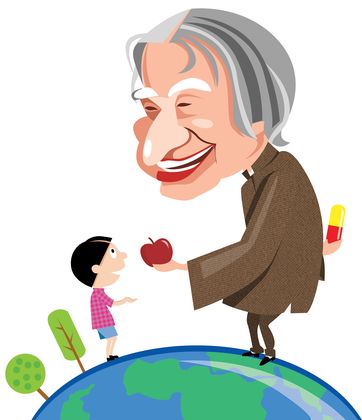Don’t give a place to disease.
—Auvaiyyar, Tamil saint-poetess
IN INDIA 2020: A Vision for the New Millennium, Dr A.P.J. Abdul Kalam begins the chapter on health care with this apt exhortation. He describes the range of health challenges facing India, covering a wide spectrum of communicable, nutritional and non-communicable diseases. As responses to these challenges are outlined, there is a strong thread connecting science to policy and also a binding commitment to equity with a passionate plea to reach the unreached.
Where are we today in realising Kalam’s vision? Several initiatives of the past two decades address the priorities set by him. But, what are the levels of success achieved and where have we fallen short? Have we effectively shaped the social and environmental determinants of health? Is universal health coverage close to becoming a reality?
Kalam’s call for advancing sanitation and clean drinking water as prime pathways for prevention of infectious diseases has found a response in the Nirmal Bharat Abhiyan and the Swachh Bharat Abhiyan. On October 2, 2019, India was declared open-defecation free. However, weak sewage disposal systems and urban garbage dumps remain a health hazard. With high levels of pollutants, India stands 120th among 122 countries ranked in the water quality index. Recently, the minister for consumer affairs revealed that, of 21 state capitals tested for quality of tap water, only Mumbai passed the potability test. Effects of air pollution and climate change were not flagged by Kalam, but their current and future health effects are major concerns now.
Infectious diseases were identified by Kalam as a high priority for prevention and control. Tuberculosis, in particular, was highlighted. While India has recently committed itself to the elimination of tuberculosis by 2025, even ahead of the Sustainable Development Goals (SDG) target of 2030, formidable challenges of case detection, treatment adherence and drug-resistant tuberculosis call for a stupendous effort. HIV/AIDS has seen more success in falling incidence and death rates, but the threat still remains among the high-risk ‘key populations’ and the young who are less risk-aware owing to a dip in campaign intensity. Malaria continues to be a threat in eastern, northeastern and central India, though Odisha’s recent record in reducing malaria mortality provides a role model. Other vector-borne diseases like dengue and chikungunya are rising threats escalated by global warming.
A number of public health interventions were advocated to lower levels of anaemia and malnutrition in women and children and reduce maternal and child mortality. Kalam emphasised that these did not require high technologies. Through a committed response, commencing with the National Rural Health Mission in 2005 and later expanding into the National Health Mission, maternal and child mortality rates have substantially improved and India is on track for reaching the 2030 SDG targets. However, the levels of child undernutrition and maternal anaemia are still very high and need a strong multi-sectoral response.
The rising threat of non-communicable diseases was also recognised by Kalam, though his optimism that many of these “are likely to decline considerably by 2020” was misplaced. His expectation of “faster decline in female cancers” is yet to be met. The recently initiated screening programme for breast, cervical and oral cancers imparts impetus to early detection of these common cancers, while treatment facilities still need to be improved. We can only wonder what his reaction would have been on the reluctance to deploy vaccination against cervical cancer, as recommended by the World Health Organization.
The rising tide of cardiovascular diseases caught his attention, especially the strong propensity of Indians for early onset coronary heart disease. He recognised the influence of altered living habits and strongly advocated prevention, even as he developed technologies for treatment like the Kalam-Raju stent. Stroke is another major cardiovascular disorder whose prevention calls for effective blood pressure control. Rheumatic heart disease is on the decline but still needs a committed programme of prevention, repair or replacement when needed. Diabetes is rising, even among the young, and needs a strong public health effort for prevention, even as treatment needs to become widely accessible and affordable. Kalam also pointed to the rise in mental health disorders, which requires a strong social and health system response.
Kalam called for universal health care as a route to ‘health for all’. He wanted health services to reach everywhere, especially through technology-enabled primary health services. India’s journey towards universal health coverage began with the National Rural Health Mission, Rashtriya Swasthya Bima Yojana and a cluster of state-funded health insurance schemes. A definitive direction has now been provided by the Ayushman Bharat scheme that combines comprehensive primary health care with financial protection for hospitalised care to nearly 50 crore Indians. Kalam the scientist would have welcomed the scheme, but carefully monitored its progress.
While Kalam was concerned about the overall health indicators of India, he would have also been alert to the vast differences between the states of India, urban and rural regions, tribal and non-tribal populations and gender groups. If he were alive today, he would be sharply questioning why there is a 12-year gap in life expectancy between Kerala and Assam or why a child under five in Assam is four times more likely to die before a child in Kerala. If we can reach the SDG goal of health and well-being for all at all ages by 2030, we would become worthy of celebrating Kalam’s birth centenary in 2031.
—Reddy is president, Public Health Foundation of India, and author of Make in India: Reaching a Billion Plus. Views expressed here are personal.


